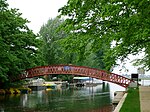Aristotle Lane is a road in north Oxford, England.The lane links North Oxford, leading from the junction of Kingston Road and Hayfield Road (close to the junction with Polstead Road), with Port Meadow to the west, via bridges over the Oxford Canal and railway. The other access to the meadow from North Oxford is via Walton Well Road to the south.
St Philip & St James Primary School is located in Aristotle Lane, having previously below in Leckford Road to the south. The Aristotle Lane Allotments are also located here. To the north of the allotments is the Burgess Field Nature Park, formerly a landfill site. In addition, there is a recreation ground.Aristotle Lane Wildlife Corridor which is located within the residential development site of Burgess Mead is a 0.25-hectare (0.62-acre) strip of land either side of a minor drainage channel which runs for some 154 metres through the site. Included is a narrow strip of land at the northern site boundary which buffers the site from the adjacent Trap Grounds. This is an area of reed and sedge beds enclosed by damp woodland dominated by willows. Its interest includes breeding water rail, reed warbler and reed bunting and it has a certain historical ornithological value due to a past history of bird ringing at the site, as well as it being the location of a television documentary about the cuckoo.
The pond/wetland created as part of the development has been successful and currently supports a dense central area of tall emergent vegetation typified by common reed and purple loosestrife, with other species at the margins including water mint and marsh marigold.
The grasslands within the wildlife corridor have their origins partly in wildflower seeding and partly due to turfing (a legacy of the developers’ sales team). Seed of guaranteed native local provenance was used to create species-rich grasslands .
The mammal shelves of sand/concrete bags installed alongside the stream channel beneath the new bridge, which is designed to permit terrestrial wildlife movement along the entire length of the watercourse.












